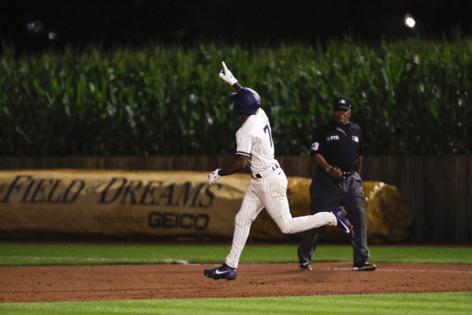Paul Sullivan: How did the White Sox fall to such depths? Gradually -- and then suddenly.
Published in Baseball
When the ball met the bat of shortstop Tim Anderson and sailed over the right-field fence of the tiny “Field of Dreams” ballpark on Aug. 12, 2021, Chicago White Sox fans rejoiced.
The ball disappeared into a cornfield as the White Sox celebrated, seemingly washing away years of frustration, disappointment and anger.
Anderson’s two-run, opposite-field home run gave the Sox a 9-8 win over the New York Yankees in the nationally televised game in Dyersville, Iowa, and announced to the world that the Sox were officially back.
Fox-32 anchor Corey McPherrin called it the greatest regular-season Sox game in history, and no one watching could really dispute him.
The long and winding Sox rebuild had led to this moment of bliss, and from the clubhouse to manager Tony LaRussa, from the front office suites of executives Rick Hahn and Ken WIlliams to the owner’s box of Chairman Jerry Reinsorf, a feeling of omnipotence was mutual.
There was no turning back now. These White Sox would be winners for years to come, with a young, exciting core that was on its way to the postseason for the second straight season, the first time in franchise history they’d play in back-to-back Octobers.
Three years and one month later, the Sox find themselves in a self-created crater that almost defies belief. Once the toast of the town, now they are simply toast.
The Sox lost their 120th game Sunday in San Diego, tying the expansion 1962 New York Mets for the most losses in a season. There are still six games remaining, starting Tuesday on the South Side against the Los Angeles Angels.
How did the Sox go from nirvana in a cornfield to the bottom of the all-time barrel in such a short time?
Here are seven easy steps:
Bringing back Tony LaRussa
Reinsdorf’s controversial decision to bring LaRussa out of retirement worked in 2021 when he led them to the postseason. But he began to experience health issues in spring training of ’22, a matter that was kept secret to give LaRussa his deserved privacy. Instead of ending the experiment and turning the team over to someone younger and more energetic, LaRussa plowed through. At one point TV cameras caught him with his eyes closed in the dugout, a warning that all was not well. The resulting reaction to “Sleeping Tony” by the media and fans was blown off by the Sox. By the time he left the team at the end of August to deal with a more important health issue, it was too late in the season to matter. He stepped down after the season and later returned as a front office advisor.
Hiring Pedro Grifol
After the ’22 season, Hahn brought in a baseball lifer with no managerial experience at the major-league level to replace LaRussa. Grifol stressed his expertise in “communication” and said his team would always hustle and play fundamentally sound ball. “With the hiring of Pedro (we) feel like we are taking a major step to putting ourselves back on track on the trajectory we all felt we were on over the previous seasons prior to last season’s disappointment,” Hahn said. Most of the same team was back, with a few newcomers, including starter Mike Clevinger. But the Sox got off to a 7-21 start and it was all downhill from there. After being dealt to the Yankees, reliever Keynan Middleton ripped the Sox clubhouse culture. “There’s no rules,” he said. “You have rookies sleeping in the bullpen during the game. You have guys missing meetings. You have guys missing PFPs, and there’s no consequences for any of this stuff.” The Sox went on to lose 101 games, and Hahn and Williams were fired.
Lack of a GM search
Reinsdorf’s search for a new general manager began and ended at Sox Park. He ignored the advice of longtime front office personnel to go outside the organization and find an up-and-coming analytically bent executive who could bring the Sox into the modern age. Instead, he turned to assistant GM Chris Getz nine days into his “search,” saying he didn’t want to “waste” a year with someone new having to learn the organization. “It doesn’t strike me as a lot (of changes are needed),” Reinsdorf said. “I think we’ll get better internally. We have a better clubhouse. Some of the problems that we had in the clubhouse were players we brought in (that) contributed to it.” That was seen as a shot at Hahn. Getz’s first move was announcing that Grifol would return in 2024.
Chris Getz’s offseason moves
At the general managers’ meetings in Arizona after the ’23 season, Getz said: “I don’t like our team.” He proceeded to cut loose disgruntled veterans like Anderson and Yasmani Grandal, traded Aaron Bummer to the Atlanta Braves for five players and signed low-level free agents including Paul DeJong, Chris Flexen, Martin Maldonado and others. Starter Erick Fedde, who had a comeback season in Korea, was signed to an affordable two-year, $15 million deal. The 2024 Sox would rely on improved defense and pitching, Getz said. While Getz was proven right in his decisions on Anderson and Grandal, the only incoming player who enjoyed real success was Fedde.
Trading Dylan Cease
As bad as the 2024 team looked on paper, at least the Sox had a rotation in the spring that included a true ace in Dylan Cease, and three quality pitchers in Fedde, converted reliever Garrett Crochet and Michael Kopech. Surely they could scratch out 60 or 65 wins. But Getz dealt Cease to the San Diego Padres near the end of spring training without having anyone to fill the void and had moved Kopech to the bullpen after giving him a brief shot in Cactus League play. Cease has been a key part of a playoff-bound Padres rotation, while Kopech found his groove in the Los Angeles Dodgers bullpen after being dealt at the trade deadline.
Blowing the ’24 trade deadline
Crochet had been mentioned in trade rumors since his hot start in April, but a leaked demand for a contract extension from any team acquiring him damaged his value. For Fedde, Kopech and Tommy Pham, the only major-league-ready player the Sox got in return in a three-way deal with the St. Louis Cardinals and Dodgers was third baseman Miguel Vargas, who was hitting .108 coming into Sunday with a .162 slugging percentage in 111 at-bats. MLB Network analyst Mark DeRosa was asked the next day what Getz should’ve done when he was hooked up on a three-way call with Cardinals president John Mozeliak and Dodgers president Andrew Friedman. “Hang up,” DeRosa replied. Too late.
Sticking with Pedro Grifol
Getz had many opportunities to fire Grifol. The Sox started out 3-22, but Grifol remained. They were 27-71 at the All-Star break, but no change was made. They lost 17 straight games after the break to tie the American League record of 21 straight losses. No movement. Finally, after the Sox won a game, Grifol was fired on Aug. 8, and replaced by interim manager Grady Sizemore, a coach with unspecified duties who wasn’t on anyone’s radar by Getz’s. Sizemore’s team was 8-30 heading into Sunday, a .211 winning percentage even worse than Grifol’s. The Corn Game was a distant memory as the Sox closed in on infamy.
____
©2024 Chicago Tribune. Visit chicagotribune.com. Distributed by Tribune Content Agency, LLC.







Comments